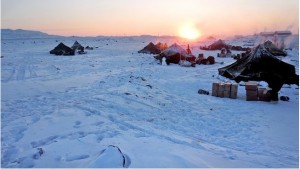Munk-Gordon Arctic Security Program
Response capacity in Arctic, already stretched, faces fast-growing challenges as North develops: Report
 Inadequate risk assessment, planning and training are among the gaps in many parts of Canada’s Arctic, compounding the challenges of brutal weather, vast distances, difficult transportation and spotty communications and exposing the region’s residents to the ever increasing risks of natural and man-made disasters and emergencies, according to a major new report released today.
Inadequate risk assessment, planning and training are among the gaps in many parts of Canada’s Arctic, compounding the challenges of brutal weather, vast distances, difficult transportation and spotty communications and exposing the region’s residents to the ever increasing risks of natural and man-made disasters and emergencies, according to a major new report released today.
In the report experts identify seven key recommendations and set priorities for emergency preparedness, synthesized from a series of hearings in each of Canada’s three northern territories, concluded by a national roundtable hosted by the Munk-Gordon Arctic Security Program.
The report details emergency management capacities in the Arctic today and its future needs in light of rapidly expanding international interest in the region’s natural resources, as a shipping corridor and other purposes. It examines the overall emergency management and the related policy environment in Canada, and includes search and rescue (SAR).
“Despite the best efforts of volunteers, who form the backbone of emergency response in the North, there are still deficiencies in the system caused by a lack of tools, plans, and training that are putting lives at risk. This risk and severity of emergencies will only increase with climate change and intensified activity in the region,” says Sara French, director of the Munk-Gordon Arctic Security program, a collaboration between the Walter and Duncan Gordon Foundation and the Munk School of Global Affairs at the University of Toronto.
“Floods, forest fires, avalanches, earthquakes, pandemics-the list of emergency concerns is long. We hope this report helps to guide preparations for adequate response ability in Canada’s North.”
In the North, major emergency responses are typically launched from Halifax, Trenton or Victoria -five or six hours away by plane in good weather.
Processes used to trigger federal assistance vary between jurisdictions, creating complication, and responders from the south are often unfamiliar with the area and general circumstances with which they are dealing.
The new report builds on one last fall on federal search and rescue activities prepared by the federal Auditor General’s Office, which underlined a need to invest in new equipment, improve access to training and accreditation of SAR staff, update the Search and Rescue Mission Management System and complete tendering on fixed-wing search and rescue aircraft.
According to the new report, the federal and public dialogue on emergency management has tended to emphasize the search for and rescue of visitors to the region, as opposed to the emergency response needs more generally of northern residents. “This has created the perception among many in the North that they are taking a backseat to visitors to the region, especially concerns related to increase use of the Northwest Passage.”
The report notes that hundreds of ground and inland water searches occur every year.
More common emergencies include forest and tundra fires, floods, power outages, blizzards – events that “are becoming not only more frequent, but more severe.” As well, “there is at least one earthquake a week in the North, but to date this has luckily only happened outside of populated areas.”
The report points to an event in August, 2010 as a harbinger of future calamities: the cruise ship Clipper Adventurer hit a rock, making refugees of more than 120 passengers in the small hamlet of Kugluktuk, Nunavut, population 1,500. Without any plan in place, the hamlet did their best to take care of the stranded passengers’ basic needs.
“But just because Kugluktuk was able to respond, does not mean it was ‘ready’ in the common understanding of emergency preparedness. The hamlet’s planning priorities are education and health, with search and rescue fifth on the list and power failures during the winter months topping the list of community emergency concerns.”
“A cruise ship running aground was not even on their radar.”
Though local emergency responders will always take action whenever a situation arises, there is often confusion as to who is supposed to be in charge along increasingly busy, especially in coastal communities.
According to the report, notions about emergency response needs in the North are also skewed by the media’s tendency “to focus on big, newsworthy events such as oil spills or cruise ship accidents – not the daily emergencies that most northerners fear, such as flooding, landslides, and forest fires.”
Emergency responders revealed specific concerns around the issue of heavy jet aircraft capable of landing on gravel runways.
The Boeing 737-200 series, first produced in the 1970s, was the last commercial jet aircraft of its’ size capable, when suitably modified, of landing on gravel runways. Newer models with more modern high bypass engines are not able to be modified for gravel use.
“This means that as the remaining gravel modified aircraft age and become economically nonviable there is no suitable replacement. Only 10 runways in the entire three Territories are paved, although others are sufficiently long to handle the B737. Lack of pavement is also delaying air carriers upgrading to newer, more fuel efficient, greener aircraft. This will eventually become a challenge for northern communities.”
The lack of paved runways in the Arctic also limits the emergency landing options for large aircraft operating on the polar overflight routes.
The recommendations in each section of the full report flow from the discussion sessions and participants at the National Roundtable on Arctic Emergency Preparedness.
Considered the seven top recommendations:
- National authorities should place needs of northern residents at the forefront in policies discussions at the national level, as opposed to an exclusive focus on visitors to the region.
- Territorial governments should make available and encourage skill development among community members and volunteer responders, including: traditional and local knowledge for newcomers; basic and wilderness first aid; CPR, including the use of Automated External Defibrillators (AEDs); radio operator training; Incident command system (ICS); Emergency Operating Centre (EOC); Ground Search and Rescue (GSAR); GPS, as well as how to use a map and compass; boat operator license; snowmobile and ATV operator training; small engine mechanics; technical rescue skills: swift water rescue, crevasse rescue, avalanche rescue; and environmental response training. To make this training possible, the Joint Emergency Preparedness Program should be reinstated to full capacity.
- Training at all levels should follow a “two-way knowledge exchange”model, where there is not just training provided by official organizations to community members and volunteers, but there are also opportunities for traditional and local knowledge holders to share their knowledge with territorial and federal level officials. In addition, training programs should be reflective of northern realities and offered in Indigenous languages.
- All communities should complete emergency plans based on the unique situation of their community. However, these plans should be more than a “book on the shelf”, funding should be provided for their regular review and updating, including training new personnel on how to use the plan.
- The call from the Government of the Northwest Territories, which was endorsed by the regional roundtable held in that territory, to place some federal search and rescue assets in Yellowknife closer to the communities that they serve should be answered. The federal government should also provide for adequate manpower for the aircrafts already based in the territory.
- Territorial and First Nations governments should make SPOT or other devices readily available to community members, building on the program in Nunavut. These should ideally be two-way devices.
- Cross-border initiatives between the Government of Canada and the Government of the United States of America should be considered and existing cooperative arrangements between sub-state actors, such as the State of Alaska and the Territory of Yukon supported. To this end, Canada and the United States should fully explore setting up a Canada/US Coast Guard Forum for the Arctic.
About the Munk-Gordon Arctic Security Program
A partnership between the Canada Centre for Global Security Studies at the Munk School of Global Affairs, University of Toronto and the Walter and Duncan Gordon Foundation, the Munk-Gordon Arctic Security Program is dedicated to studying and promoting four overarching areas of concern: public opinion research, Arctic Council, Arctic Peoples and Security, and emergency management. Program details, publications and opinion polls can be accessed at http://www.gordonfoundation.ca. Follow @ArcticSecurity on Twitter.
* * * * *
News release in full, click here
Example coverage:
The Canadian Press, “Focus northern emergency response on people who live there, not tourists: report,” click here
Sun Media / QMI, English, “Canadian Arctic unprepared for emergencies: report” click here, French, “Les défis de l’Arctique font l’objet de recommandations,” click here
CBC North, “Focus northern emergency response on Northerners: report” click here;
 CBC TV, click here (starts ~32 minutes)
CBC TV, click here (starts ~32 minutes)
Agencia EFE (Spain), “Expertos advierten de que Canadá no está preparada para desastres en Ártico,” click here
Full coverage summary, click here